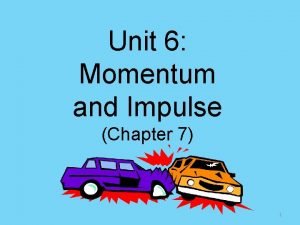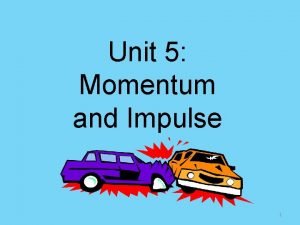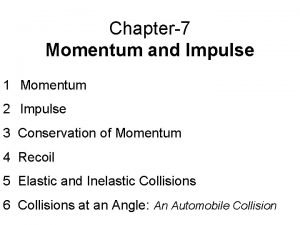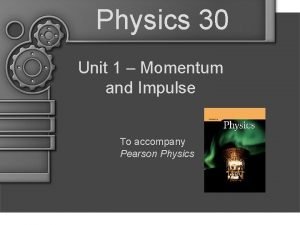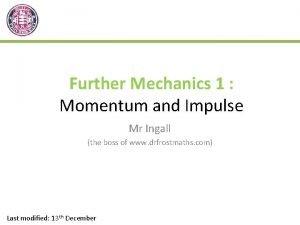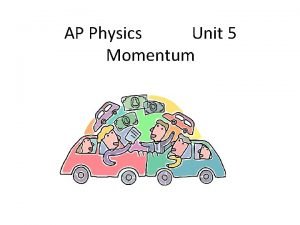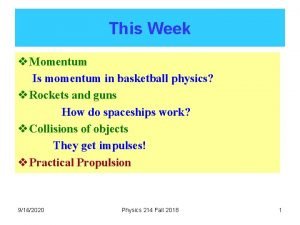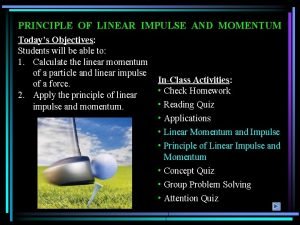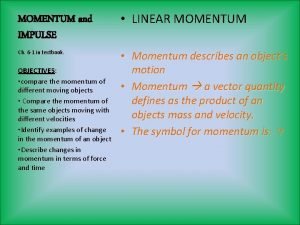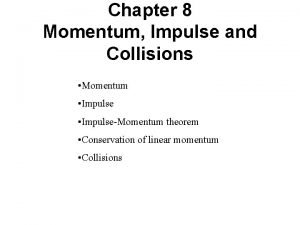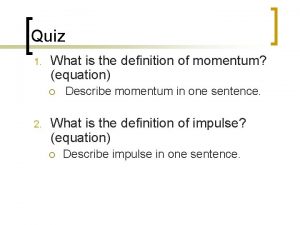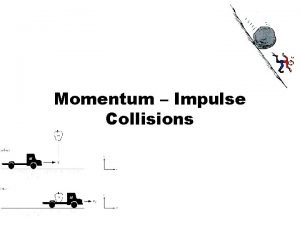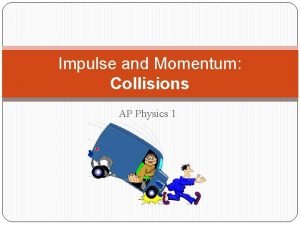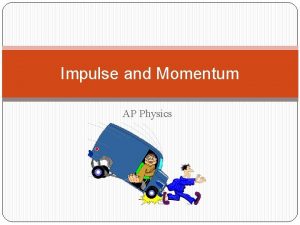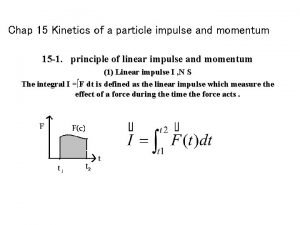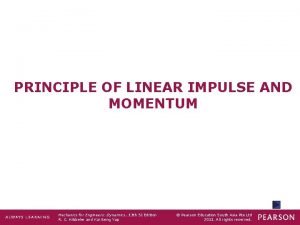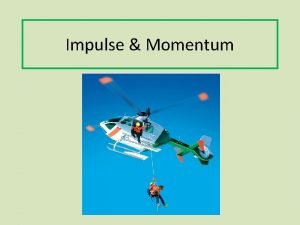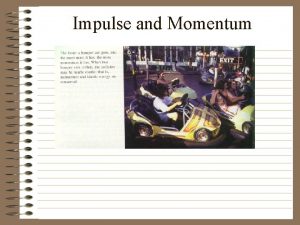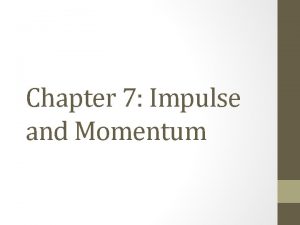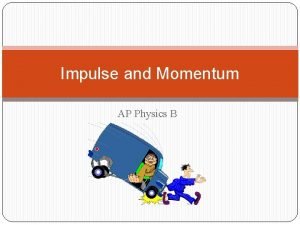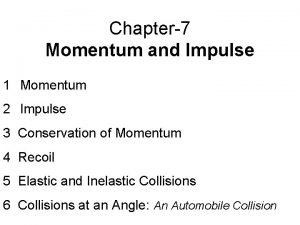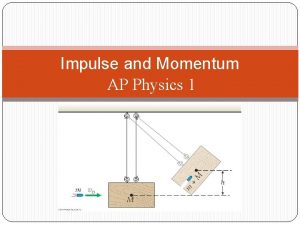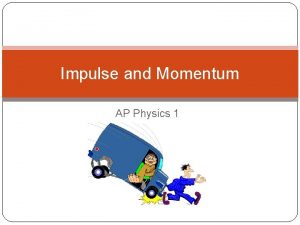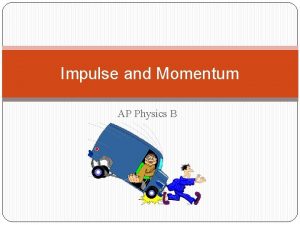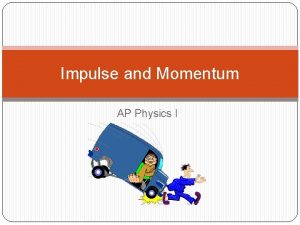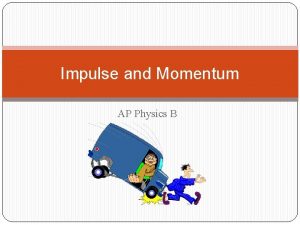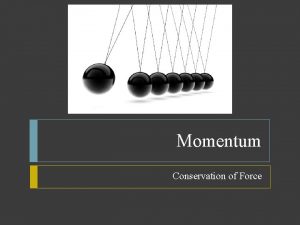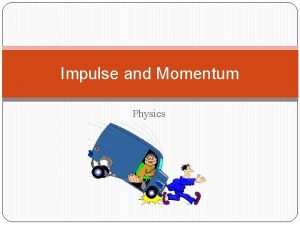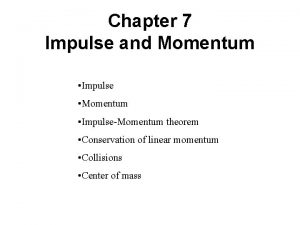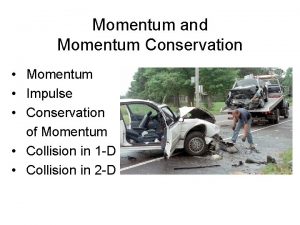Unit 5 Momentum and Impulse 1 Momentum What


























- Slides: 26

Unit 5: Momentum and Impulse 1

Momentum What does it mean to have momentum? 2

Sports Example • Coach: “We have all the momentum. Now we need to use that momentum and bury them in the third quarter. ” • What does the coach mean? • His team is on the move and will take some effort to stop. 3

Momentum • All objects in motion have momentum! • What factors determine how much momentum an object has? 4

Linear Momentum • Linear momentum (p) – product of an object’s mass and velocity. • Momentum is a vector that points in the same direction as the velocity. • Units: kg *m/s 5

• Example #1: A freight train moves due north with a speed of 1. 4 m/s. The mass of the train is 4. 5 x 105 kg. How fast would an 1800 kg automobile have to be moving due north to have the same momentum? ptrain = mtrainvtrain =(4. 5 x 105 kg)(1. 4 m/s) = 630, 000 kg*m/s pauto = mautovauto = 350 m/s 6

Varying Forces • Forces are not always constant. Many forces change as they are applied over a period of time. Average Force (F) t 0 tf When a baseball hits a bat, the ball is in contact with the bat for a short time interval. The force reaches its maximum value towards the middle of the time interval. 7

Impulse • For a baseball to be hit well, both the size of the force and the time of contact (Follow through!) are important. • Impulse (J) – product of the average force F and the time interval Δt over which the force acts. • Units: Newton * seconds (Ns) • Impulse is a vector that points in the same direction as the average force. 8

Impulse-Momentum Theorem • Remember Newton’s 2 nd Law: • And acceleration is defined as • Substitute: • Rearrange: Impulse-Momentum Theorem 9

Impulse-Momentum Theorem • Another way to write theorem is: • In words: Impulse = Change in Momentum 10

• Example #2: A volleyball is spiked so that its incoming velocity of +4. 0 m/s is changed to an outgoing velocity of -21 m/s. The mass of the volleyball is 0. 35 kg. What impulse does the player apply to the ball? v 0 = +4. 0 m/s vf = -21 m/s m = 0. 35 kg 11

Impulse Why doesn’t the egg break? ? http: //www. youtube. com/watch? v=7 RSUjxi. Zn. ME 12

Impulse An object with 100 units of momentum must experience 100 units of impulse to be brought to a stop. This can come from any combination of Force x time. As time Force 13

Conservation of Momentum • closed system – system where nothing is lost and no net external forces act. • Law of Conservation of Momentum – the total momentum of any closed system does not change; the momentum before an interaction equals the momentum after the interaction. 14

Collisions in 1 -Dimension Inelastic • Inelastic collision- a collision in which the objects stick together and move with one common velocity after colliding. • 2 objects 1 object 15

Inelastic Collisions Example 3: Two cars collide and become entangled. If car #1 has a mass of 2000 kg and a velocity of 20 m/s to the right, and car #2 has a mass of 1500 kg and a velocity of 25 m/s to the left, find the velocity of the system after the collision. BEFORE Collision 1 AFTER Collision 2 16

Explosions • Explosion- process of one object splitting into 2 (or more) objects • Recoil- kickback; momentum opposite a projectile • 1 object 2 objects (or more) 17

Explosions Example 4: Starting from rest, two skaters push off each other on smooth level ice. Skater 1 has a mass of 88 kg and Skater 2 has a mass of 54 kg. Upon breaking apart, Skater 2 moves away with a velocity of 2. 5 m/s to the right. Find the recoil velocity of Skater 1. BEFORE Explosion 1 2 AFTER Explosion 1 2 18

Collisions in 1 -Dimension Elastic • Elastic collision – a collision in which the colliding objects bounce off each other. • 2 objects stay 2 objects 19

Elastic Collisions BEFORE Collision 1 AFTER Collision 2 ? 1 2 ? This is the hardest type of problem since there are two pieces on both sides! 20

Elastic Collisions Example • 21

Elastic Collisions BEFORE Collision 1 AFTER Collision 2 ? 1 2 ? If there are 2 unknowns we would need to use Conservation of Energy and solve a system of equations… We may do this type of problem, but NOT YET! 22

Is Kinetic Energy Conserved? • Elastic Collision: KE is conserved • Inelastic Collision: KE is NOT conserved 23

Practice Problem #1 • 24

Practice Problem #2 • An automobile accident investigator needs to determine the initial westerly velocity of a Jeep (m=1720 kg) that may have been speeding before colliding head-on with a Volkswagen (m=1510 kg) that was moving with a velocity of 21 m/s east. The speed limit on the road was 55 mi/hr. After the collision, the Jeep and Volkswagen stuck together and continued to travel with a velocity of 4. 3 m/s west. a. Find the initial westerly velocity of the Jeep. b. Was the jeep speeding? 25

Practice Problem #2 • 26
 Unit 6 momentum and impulse
Unit 6 momentum and impulse Units of momentum
Units of momentum Conservation of momentum in sports
Conservation of momentum in sports Momentum and impulse physics 30
Momentum and impulse physics 30 Further mechanics 1 unit test 1 momentum and impulse
Further mechanics 1 unit test 1 momentum and impulse Impulse and momentum
Impulse and momentum Physics 03-02 potential energy and conservative forces
Physics 03-02 potential energy and conservative forces Impulse and momentum in basketball
Impulse and momentum in basketball Principle of linear impulse and momentum
Principle of linear impulse and momentum Linear momentum and linear impulse
Linear momentum and linear impulse Importance of momentum and impulse
Importance of momentum and impulse Poem about momentum and impulse
Poem about momentum and impulse Linear momentum and impulse
Linear momentum and impulse Importance of momentum and impulse
Importance of momentum and impulse Momentum and impulse formula sheet
Momentum and impulse formula sheet Units momentum
Units momentum Momentum units
Momentum units Impulse and momentum
Impulse and momentum Mel physics
Mel physics Define linear momentum and impulse
Define linear momentum and impulse Impulse and momentum
Impulse and momentum Collisions ap physics 1
Collisions ap physics 1 Implusive force
Implusive force Momentum
Momentum Kinetics of a particle: impulse and momentum
Kinetics of a particle: impulse and momentum Dynamics impulse and momentum solved problems
Dynamics impulse and momentum solved problems Principle of angular impulse and momentum
Principle of angular impulse and momentum
